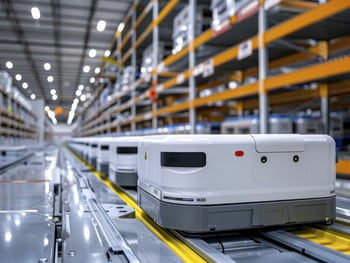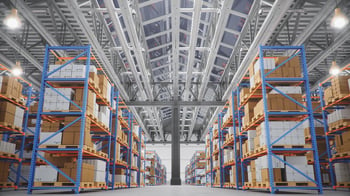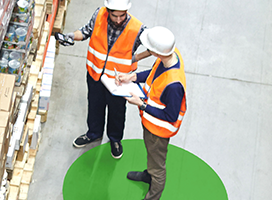
Micro-fulfillment models are changing the game for online retailers and customers alike, removing the need to ship orders across states and instead fulfilling orders right in the customer’s area. This can sometimes shorten fulfillment times to just a few hours.
For retailers, this means more warehousing and fulfillment flexibility, lower shipping costs, and all the perks of bringing customers into the store. For consumers, it equals faster fulfillment and sustainable practices. Here’s how it’s happening.
How Microfulfillment Centers Work for eCommerce
Microfufillment is an eCommerce fulfillment strategy that enables sellers to store inventory closer to the customer. Traditionally, retailers depended on a smaller number of remotely located, massive distribution centers. Those distribution centers could be up to 2 million square feet in size or more, whereas a microfulfillment center might be around 10,000 sf.
Because of their smaller size, these distribution centers are much more nimble. Businesses can more easily find space to store popular products close to where shoppers live. Some online businesses are even using their retail stores as microfulfillment centers for online orders.
Challenges With Using Traditional Fulfillment Strategies
Let’s assume your business uses a traditional order fulfillment strategy, which involves having a series of large distribution centers located in strategic locations. These centers are usually located in areas where real estate is more affordable, meaning they aren’t necessarily close to the customers who purchase the products or businesses that supply the inventory.
While the above is the traditional way of doing things, that doesn’t necessarily mean it’s the best. For example, these massive buildings are often plagued by a variety of challenges like inefficient space utilization, poor inventory management, labor-intensive operations, and delayed deliveries. These challenges alone make an alternative, like microfulfillment centers, worth considering.
Pros and Cons of Using Microfulfillment
Switching to microfulfillment centers is probably a significant change for many organizations that are accustomed to using traditional methods for storing inventory and fulfilling orders. If your business is considering using microfulfillment strategies, here are some of the pros and cons of doing this.
The pros of implementing a microfulfillment strategy for your business include:

- Faster last-mile fulfillment — Because products are stored closer to customers, this prompts faster pickups and deliveries after the order is placed. In some cases, orders can be on a customer’s doorstep in a matter of hours.
- Reduce labor costs — With the use of automation and technology solutions, microfulfillment centers often require less human labor, which reduces costs in this area.
- Lower logistics costs—The proximity to customers and the rise of automation solutions allow businesses to reduce some logistics expenses, such as fuel costs and capital expenditures for massive warehouse space.
- More sustainable options — Having fulfillment centers closer to your final customers can lower greenhouse gas emissions, particularly when you stop using large decentralized distribution centers.
- Increased customer satisfaction — Fast, accurate delivery of products elevates the customer experience, which builds improved brand awareness and loyalty.
- More sales — By offering a better customer experience, you address common barriers that cause customers to seek out competitors — high shipping costs and slow delivery times. This will increase your sales and improve your overall results.
Before you commit to using microfulfillment, make sure you understand the potential downside, which include:
- Initial investment — If you already have a traditional model in place, capital investment will be required to establish quality microfulfillment centers. This investment should include feasibility studies and the implementation of technology solutions for optimum efficiency.
- Storage capacity limits — The microfulfillment strategy requires that you optimize smaller spaces, but there will always be limits to the amount of products you can hold in a more compact warehouse.
- Inventory management issues — Decentralizing your inventory through the use of several microfulfillment centers can complicate the inventory management process.
Optimizing Your eCommerce Operations for Microfulfillment
Target received considerable buzz in 2020 when it began using its existing stores as fulfillment centers. This strategy helped the company get a piece of Amazon’s strong lock on the eCommerce sector. While this worked well during a pandemic, when many stores were empty, it may not be the most sustainable strategy.
In 2022, Target began opening separate microfulfillment centers, with plans to build more in the coming years. This approach is allowing the company to overcome shipping constraints and reduce costs. If you want to pursue microfulfillment for your eCommerce business, here are some ways to optimize your strategy.
Optimize Storage
The type of storage you would use in a major distribution center may not be appropriate for a microfulfillment operation. You’ll want to build everything on a smaller scale and likely won’t have to make room for things like autonomous vehicles or mezzanine shelving. Instead, you’ll use smaller, more efficient shelving units that are easily accessible by your workers.
Support Strategic Stocking
 Microfuifllment centers can’t carry every product you sell. Instead, you’ll usually stock the most popular items in these small warehouses so they can be delivered quickly to customers. Other items might still come from a larger, more distributed warehouse.
Microfuifllment centers can’t carry every product you sell. Instead, you’ll usually stock the most popular items in these small warehouses so they can be delivered quickly to customers. Other items might still come from a larger, more distributed warehouse.
Leverage Data Insights
How will you know which items to stock in your microfulfillment centers and how much of each item is optimal? This is where you’ll use data insights to accurately predict demand so you can have the proper inventory levels on hand, which prevents unnecessary overstocking or costly stockouts.
Invest in Technology Solutions
Finally, you can invest in technology solutions, similar to how you would do so in a traditional warehouse. For example, RFID tags can provide real-time product visibility, and mobile powered carts can help you efficiently stock and fulfill orders.
Ongoing shifts in the retail landscape driven by changing customer demands and expanding eCommerce capabilities have given rise to the growth of microfulfillment. By moving fulfillment closer to customers, sellers enjoy a variety of benefits, and customers get a better overall experience. It’s a win-win.












